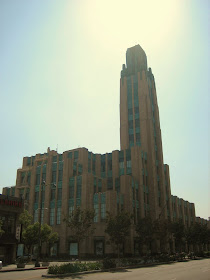In 1775, the Franciscans founded Mission San Juan Capistrano. With its beautiful gardens and fountains, Mission San Juan Capistrano, which is located in Orange County about an hour south of L.A., is one of the prettiest of California's historic missions.


Through the missions, the Franciscans introduced Spanish farming practices and crops such as wheat, citrus fruits, figs, grapes, and olives to California. The Spanish operated the missions and their farms as coercive labor camps. Indian converts, once baptized, were "attached" to the mission and were obligated to remain at the mission and work the land. The Spanish actively searched for runaways and forcibly returned escaped Indians to the missions.
Here is a statue of Father Junipero Serra baptizing an Indian boy:

By mistreating the indigenous population, destroying traditional food sources, and introducing new communicable diseases to the region, the Spanish decimated the Indian population of California. In 1770, there were at least 300,000 Indians in California; by the mid-1800s, the Indian population was reduced by more than half.
The Catholic Church still owns and operates 19 of California's historic missions. The California missions usually have low-quality exhibits and weird dioramas that tend to gloss over their troubling histories. Here is one of the dioramas at San Juan Capistrano:

The 1776 adobe church at San Juan Capistrano, referred to as Father Serra's chapel, is the oldest known building in California. The chapel has an ornate golden altar and a traditional painted wooden ceiling:
 A niche-statue inside of Father Serra's chapel:
A niche-statue inside of Father Serra's chapel:
In 1796, the Franciscans, using Indian labor, constructed a large stone church at Mission San Juan Capistrano with limestone mortar and stones from a nearby quarry. The building, which was the largest of the California Mission churches, collapsed during an earthquake in 1812 killing 40 Indians who were inside attending mass. The older church, built out of traditional adobe, survived the earthquake. Here are two views of the ruins of the great stone church:

 Bells were an integral part of mission life and were used to signal the beginning of the work day, breaks for meals, and prayer time.
Bells were an integral part of mission life and were used to signal the beginning of the work day, breaks for meals, and prayer time. 

 A view of the coast in nearby Laguna Beach:
A view of the coast in nearby Laguna Beach:
View Mission San Juan Capistrano in a larger map






























